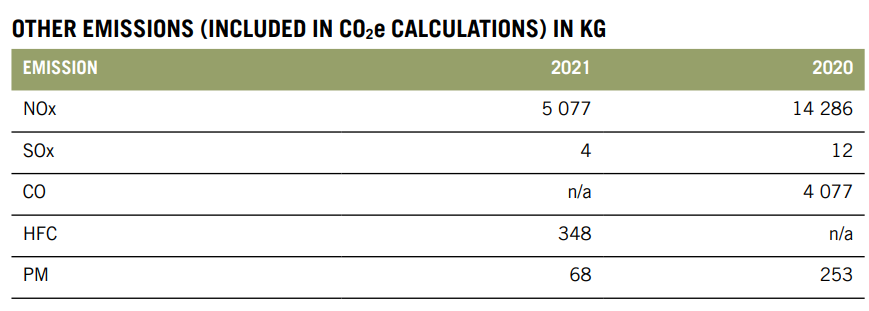Key Performance Indicator GRI SRS-305-1: Direct (Scope 1) GHG emissions
The reporting organization shall report the following information:
a. Gross direct (Scope 1) GHG emissions in metric tons of CO2 equivalent.
b. Gases included in the calculation; whether CO2, CH4, N2O, HFCs, PFCs, SF6, NF3 or all.
c. Biogenic CO2 emissions in metric tons of CO2 equivalent.
d. Base year for the calculation, if applicable, including:
i. the rationale for choosing it;
ii. emissions in the base year;
iii. the context for any significant changes in emissions that triggered recalculations of base year emissions.
e. Source of the emission factors and the global warming potential (GWP) rates used, or a reference to the GWP source.
f. Consolidation approach for emissions; whether equity share, financial control, or operational control.
g. Standards, methodologies, assumptions, and/or calculation tools used.
Key Performance Indicator GRI SRS-305-2: Energy indirect (Scope 2) GHG emissions
The reporting organization shall report the following information:
a. Gross location-based energy indirect (Scope 2) GHG emissions in metric tons of CO2 equivalent.
b. If applicable, gross market-based energy indirect (Scope 2) GHG emissions in metric tons of CO2 equivalent.
c. If available, the gases included in the calculation; whether CO2, CH4, N2O, HFCs, PFCs, SF6, NF3, or all.
d. Base year for the calculation, if applicable, including:
i. the rationale for choosing it;
ii. emissions in the base year;
iii. the context for any significant changes in emissions that triggered recalculations of base year emissions.
e. Source of the emission factors and the global warming potential (GWP) rates used, or a reference to the GWP source.
f. Consolidation approach for emissions; whether equity share, financial control, or operational control.
g. Standards, methodologies, assumptions, and/or calculation tools used.
Our overall consumption of energy in 2021 increased compared with 2020, due to fewer Covid-19 related constraints for our operations. Our only primary energy source was gas. A total of 4 586 MWh (2020: 3 931 MWh) was used, plus another 3 615 MWh (2020: 2 336 MWh) from district heating systems. A total of 16 481 MWh of electricity was consumed (2020: 15 632 MWh). The primary energy emissions amount to 874 t CO2 e (1 009 t CO2 e in 2020). District-heating-related emissions increased to 570 t CO2 e (411 t CO2 e in 2020). The data for district heating consumption is constant subject to fluctuations because ancillary costs are reported with a delay from landlords for the past two years. Additional Scope 2 emissions from electricity consumption amount to 1 436 t CO2 e (previous year: 1 146 t CO2 e). Location-based emissions would have been 3 564 t CO2 e (2020: 3 647 t CO2 e). The systematic purchase of green electricity products and Energy Attribute Certificates in Europe, the US and Canada is having a significant impact and can compensate partly for the increase in electricity consumption. Our “Guiding document for renewable energy purchase” manifests our strategy and targets and is a helpful tool to streamline renewable energy purchases within the group.
Key Performance Indicator GRI SRS-305-3: Other indirect (Scope 3) GHG emissions
The reporting organization shall report the following information:
a. Gross other indirect (Scope 3) GHG emissions in metric tons of CO2 equivalent.
b. If available, the gases included in the calculation; whether CO2, CH4, N2O, HFCs, PFCs, SF6, NF3, or all.
c. Biogenic CO2 emissions in metric tons of CO2 equivalent.
d. Other indirect (Scope 3) GHG emissions categories and activities included in the calculation.
e. Base year for the calculation, if applicable, including:
i. the rationale for choosing it;
ii. emissions in the base year;
iii. the context for any significant changes in emissions that triggered recalculations of base year emissions.
f. Source of the emission factors and the global warming potential (GWP) rates used, or a reference to the GWP source.
g. Standards, methodologies, assumptions, and/or calculation tools used.
Key Performance Indicator GRI SRS-305-5: Reduction of GHG emissions
The reporting organization shall report the following information:
a. GHG emissions reduced as a direct result of reduction initiatives, in metric tons of CO2 equivalent.
b. Gases included in the calculation; whether CO2, CH4, N2O, HFCs, PFCs, SF6, NF3, or all.
c. Base year or baseline, including the rationale for choosing it.
d. Scopes in which reductions took place; whether direct (Scope 1), energy indirect (Scope 2), and/or other indirect (Scope 3).
e. Standards, methodologies, assumptions, and/or calculation tools used.
